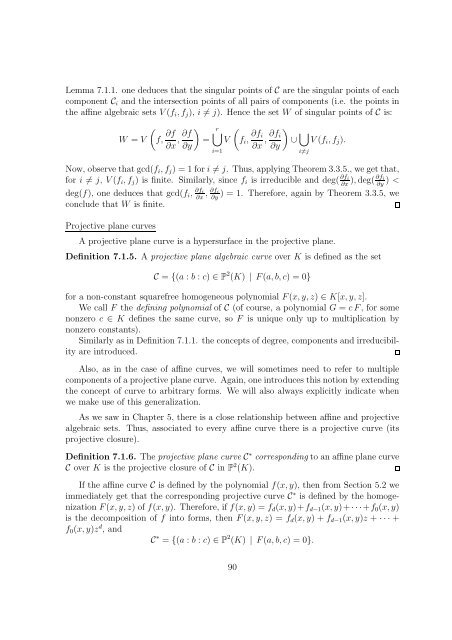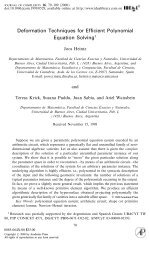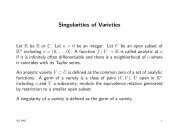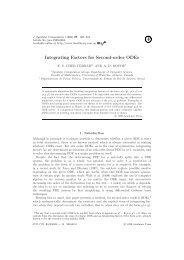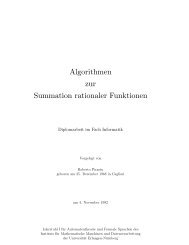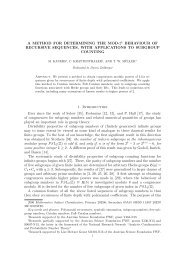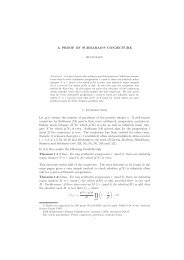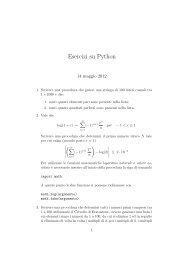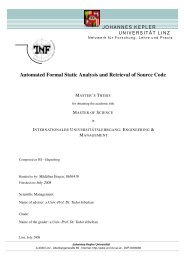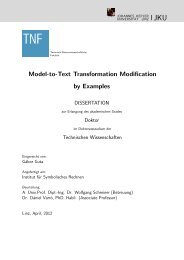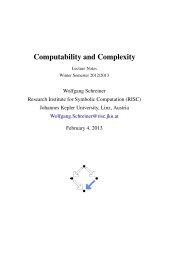Chapter 7 Local properties of plane algebraic curves - RISC
Chapter 7 Local properties of plane algebraic curves - RISC
Chapter 7 Local properties of plane algebraic curves - RISC
You also want an ePaper? Increase the reach of your titles
YUMPU automatically turns print PDFs into web optimized ePapers that Google loves.
Lemma 7.1.1. one deduces that the singular points <strong>of</strong> C are the singular points <strong>of</strong> each<br />
component C i and the intersection points <strong>of</strong> all pairs <strong>of</strong> components (i.e. the points in<br />
the affine <strong>algebraic</strong> sets V (f i , f j ), i ≠ j). Hence the set W <strong>of</strong> singular points <strong>of</strong> C is:<br />
W = V<br />
(<br />
f, ∂f<br />
∂x , ∂f )<br />
=<br />
∂y<br />
r⋃<br />
V<br />
i=1<br />
(<br />
f i , ∂f i<br />
∂x , ∂f )<br />
i<br />
∪ ⋃ V (f i , f j ).<br />
∂y<br />
i≠j<br />
Now, observe that gcd(f i , f j ) = 1 for i ≠ j. Thus, applying Theorem 3.3.5., we get that,<br />
for i ≠ j, V (f i , f j ) is finite. Similarly, since f i is irreducible and deg( ∂f i<br />
), ∂x deg(∂f i<br />
) < ∂y<br />
deg(f), one deduces that gcd(f i , ∂f i<br />
, ∂f i) = 1. Therefore, again by Theorem 3.3.5, we<br />
∂x ∂y<br />
conclude that W is finite.<br />
Projective <strong>plane</strong> <strong>curves</strong><br />
A projective <strong>plane</strong> curve is a hypersurface in the projective <strong>plane</strong>.<br />
Definition 7.1.5. A projective <strong>plane</strong> <strong>algebraic</strong> curve over K is defined as the set<br />
C = {(a : b : c) ∈ P 2 (K) | F(a, b, c) = 0}<br />
for a non-constant squarefree homogeneous polynomial F(x, y, z) ∈ K[x, y, z].<br />
We call F the defining polynomial <strong>of</strong> C (<strong>of</strong> course, a polynomial G = c F, for some<br />
nonzero c ∈ K defines the same curve, so F is unique only up to multiplication by<br />
nonzero constants).<br />
Similarly as in Definition 7.1.1. the concepts <strong>of</strong> degree, components and irreducibility<br />
are introduced.<br />
Also, as in the case <strong>of</strong> affine <strong>curves</strong>, we will sometimes need to refer to multiple<br />
components <strong>of</strong> a projective <strong>plane</strong> curve. Again, one introduces this notion by extending<br />
the concept <strong>of</strong> curve to arbitrary forms. We will also always explicitly indicate when<br />
we make use <strong>of</strong> this generalization.<br />
As we saw in <strong>Chapter</strong> 5, there is a close relationship between affine and projective<br />
<strong>algebraic</strong> sets. Thus, associated to every affine curve there is a projective curve (its<br />
projective closure).<br />
Definition 7.1.6. The projective <strong>plane</strong> curve C ∗ corresponding to an affine <strong>plane</strong> curve<br />
C over K is the projective closure <strong>of</strong> C in P 2 (K).<br />
If the affine curve C is defined by the polynomial f(x, y), then from Section 5.2 we<br />
immediately get that the corresponding projective curve C ∗ is defined by the homogenization<br />
F(x, y, z) <strong>of</strong> f(x, y). Therefore, if f(x, y) = f d (x, y)+f d−1 (x, y)+· · ·+f 0 (x, y)<br />
is the decomposition <strong>of</strong> f into forms, then F(x, y, z) = f d (x, y) + f d−1 (x, y)z + · · · +<br />
f 0 (x, y)z d , and<br />
C ∗ = {(a : b : c) ∈ P 2 (K) | F(a, b, c) = 0}.<br />
90


